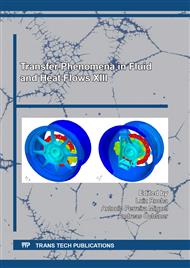[1]
IAEA (International Atomic Energy Agency). (2020). Climate Change and Nuclear Power 2020. https://www-pub.iaea.org/MTCD/Publications/PDF/PUB1911_web.pdf. Accessed 14 April (2021).
Google Scholar
[2]
Martins, F., Felgueiras, C., Smitkova, M., & Nídia, C. (2019). Analysis of Fossil Fuel Energy Consumption and Environmental Impacts in European Countries. Energies, 12, 964. https://doi.org/10.3390/en12060964.
DOI: 10.3390/en12060964
Google Scholar
[3]
Arutyunov, V. S., & Lisichkin, G. V. (2017). Energy resources of the 21st century: problems and forecasts. Can renewable enerny sources replace fossil fuels? Russian Chemical Reviews, 86(8), 777–804. http://dx.doi.org/10.1070/RCR4723.
DOI: 10.1070/rcr4723
Google Scholar
[4]
Drew, B., Plummer, A. R., & Sahinkaya, M. N. (2009). A review of wave energy converter technology. Journal of Power and Energy, 223(8), 887–902. https://doi.org/10.1243/09576509JPE782.
DOI: 10.1243/09576509jpe782
Google Scholar
[5]
López, I., & Iglesias, G. (2014). Efficiency of OWC wave energy converters: A virtual laboratory. Applied Ocean Research, 44, 63–70. https://doi.org///doi.org/10.1016/j.apor. 2013.11.001.
DOI: 10.1016/j.apor.2013.11.001
Google Scholar
[6]
Horko, M. (2007). CFD optimisation of an oscillating water column wave energy converter (Master's thesis). The university of Western Australia.
Google Scholar
[7]
Belkacem, B., & Larbi, S. (2013). Contribution to the Geometry Optimization of an Oscillating Water Column Wave Energy Converter. Energy Procedia, 36, 565–573. https://doi.org/10.1016/j.egypro.2013.07.065.
DOI: 10.1016/j.egypro.2013.07.065
Google Scholar
[8]
Boccotti, P. (2007). Comparison between a U-OWC and a conventional OWC. Ocean Engineering, 34, 799–805. https://doi.org/10.1016/j.oceaneng.2006.04.005.
DOI: 10.1016/j.oceaneng.2006.04.005
Google Scholar
[9]
Ning, D.-Z., Ke, S., Mayon, R., & Zhang, C. (2019). Numerical Investigation on Hydrodynamic Performance of an OWC Wave Energy Device in the Stepped Bottom. Frontiers in Energy Research, 7. https://doi.org/10.3389/fenrg.2019.00152.
DOI: 10.3389/fenrg.2019.00152
Google Scholar
[10]
Hayati, M., Nikseresht, A. H., & Haghighi, A. T. (2020). Sequential optimization of the geometrical parameters of an OWC device based on the specific wave characteristics. Renewable Energy, 161, 386–394. https://doi.org/10.1016/j.renene.2020.07.073.
DOI: 10.1016/j.renene.2020.07.073
Google Scholar
[11]
Ning, D., Guo, B., Wang, R., & Vyzikas, T. (2020). Geometrical investigation of a U-shaped oscillating water column wave energy device. Applied Ocean Research, 97(102105). https://doi.org/10.1016/j.apor.2020.102105.
DOI: 10.1016/j.apor.2020.102105
Google Scholar
[12]
Teixeira, P. R. F., Davyt, D. P., Didier, E., & Ramalhais, R. (2013). Numerical simulation of an oscillating water column device using a code based on Navier–Stokes equations. Energy, 61, 513–530. https://doi.org/10.4028/www.scientific.net/DDF.396.12.
DOI: 10.1016/j.energy.2013.08.062
Google Scholar
[13]
Gaspar, L. A., Teixeira, P. R. F., & Didier, E. (2020). Numerical analysis of the performance of two onshore oscillating water column wave energy converters at different chamber wall slopes. Ocean Engineering, 201. https://doi.org/10.1016/j.oceaneng.2020.107119.
DOI: 10.1016/j.oceaneng.2020.107119
Google Scholar
[14]
Deng, Z., Wang, C., Wang, P., Higuera, P., & Wang, R. (2019). Hydrodynamic performance of an offshore-stationary OWC device with a horizontal bottom plate: Experimental and numerical study. Elsevier, 115941. https://doi.org/10.1016/j.energy.2019.115941.
DOI: 10.1016/j.energy.2019.115941
Google Scholar
[15]
Bejan, A. (1997). Constructal-theory network of conducting paths for cooling a heat generating volume. International Journal of Heat e Mass Tranfer, 40(4), 799–816. https://doi.org/10.1016/0017-9310(96)00175-5.
DOI: 10.1016/0017-9310(96)00175-5
Google Scholar
[16]
Bejan, A., & Zane, J. P. (2012). Design in Nature. ASME, 134(06), 42–47. https://doi.org/ 10.1115/1.2012-JUN-4.
Google Scholar
[17]
Bejan, A. (2000). Shape and Structure: From Engineering to Nature. United Kingdom: Cambridge University Press.
Google Scholar
[18]
Rocha, L., Sylvie, L., & Bejan, A. (2012). Constructal Law and the Unifying Principle of Design (2013th ed.). Springer.
Google Scholar
[19]
Gomes, M. N., Deus, M. J., Dos Santos, E. D., & Isoldi, L. A. (2019). Analysis of the Geometric Constraints Employed in Constructal Design for Oscillating Water Column Devices Submitted to the Wave Spectrum through a Numerical Approach. Defect and Diffusion Forum, 390, 193–210. https://doi.org/10.4028/www.scientific.net/DDF.390.193.
DOI: 10.4028/www.scientific.net/ddf.390.193
Google Scholar
[20]
Gomes, M. das N., Lorenzini, G., Rocha, L. A. O., Santos, E. D., & Isoldi, L. A. (2018). Constructal Design Applied to the Geometric Evaluation of an Oscillating Water Column Wave Energy Converter Considering Different Real Scale Wave Periods. Journal of Engineering Thermophysics, 27(2), 173–190. https://doi.org/10.1134/S1810232818020042.
DOI: 10.1134/s1810232818020042
Google Scholar
[21]
Letzow, M. (2014). Avaliação geométrica da câmara de um dispositivo OWC onshore inserido em um tanque com rampa triangular em escala real empregando constructal design (Master's thesis). Federal University of Rio Grande, Brazil. Retrieved from https://ppgeo.furg.br/dissertacoes-e-teses/41-publicaes-de-2014/138-10508dissertacao-max-letzow.
DOI: 10.5380/rber.v6i3.52992
Google Scholar
[22]
Letzow, M., Lorenzini, G., Barbosa, D., Hübner, R., Rocha, L., Gomes, M., Isoldi, L., & Dos Santos, E. (2020). Numerical Analysis of the Influence of Geometry on a Large Scale Onshore Oscillating Water Column Device with Associated Seabed Ramp. International Journal of Design & Nature and Ecodynamics, 873–884. https://doi.org/10.18280/ijdne.150613.
DOI: 10.18280/ijdne.150613
Google Scholar
[23]
Falcão, A. F. de O. (2010). Wave energy utilization: A review of the technologies. Renewable and Sustainable Energy Reviews, 14, 899–918. https://doi.org/10.1016/j.rser.2009.11.003.
DOI: 10.1016/j.rser.2009.11.003
Google Scholar
[24]
Dean, R. G., & Dalrymple, R. A. (1991). Water wave mechanics for engineers and scientists (Vol. 2). Singapura: World Scientific. https://doi.org/10.1142/1232.
Google Scholar
[25]
Barreiro, T. G. (2009). Estudo da interação de uma onda monocromática com um conversor de energia (Master's thesis). Faculty of Science and Technology, Universidade Nova de Lisboa.
Google Scholar
[26]
GOMES, M. das N. (2014). Design Construtal de dispositivos conversores de energia das ondas do mar em energia elétrica do tipo coluna de água oscilante (Doctor's Thesis). Federal University of Rio Grande do sul, Brazil. Retrieved from https://www.lume.ufrgs.br/handle/10183/109161.
DOI: 10.14808/sci.plena.2017.049915
Google Scholar
[27]
Hirt, C. W., & Nichols, B. D. (1981). Volume of fluid (VOF) method for the dynamics of free boundaries. Journal of Computational Physics, 39, 201–225. https://doi.org/10.1016/0021-9991(81)90145-5.
DOI: 10.1016/0021-9991(81)90145-5
Google Scholar
[28]
Simonetti, I., Cappietti, L., Elsafti, H., & Oumeraci, H. (2017). Optimization of the geometry and the turbine induced damping for fixed detached and asymmetric OWC devices: A numerical study. Energy, 139, 1197–1209. https://doi.org/10.1016/j.energy.2017.08.033.
DOI: 10.1016/j.energy.2017.08.033
Google Scholar
[29]
SCHLICHTING, H. (1979). Boundary Layer Theory (7th ed.). New York: McGraw-Hill.
Google Scholar
[30]
Marjani, A., Castro, F., Bahaji, M., & Filali, B. (2006). 3D unsteady flow simulation in an OWC wave conventer plant. Renewable Energy & power quality journal, 1, 350–355. https://doi.org/10.24084/REPQJ04.452.
DOI: 10.24084/repqj04.452
Google Scholar
[31]
Dizardji, N., & Sajadian, S. E. (2011). Modeling and optimization of the chamber of OWC system. Energy, 36, 2360–2366. https://doi.org/10.1016/j.energy.2011.01.010.
DOI: 10.1016/j.energy.2011.01.010
Google Scholar
[32]
Ferziger, J. H., & Peric, M. (1996). Computacional Methods for Fluid Dynamics (1st ed.). Berlim: Springer.
Google Scholar


